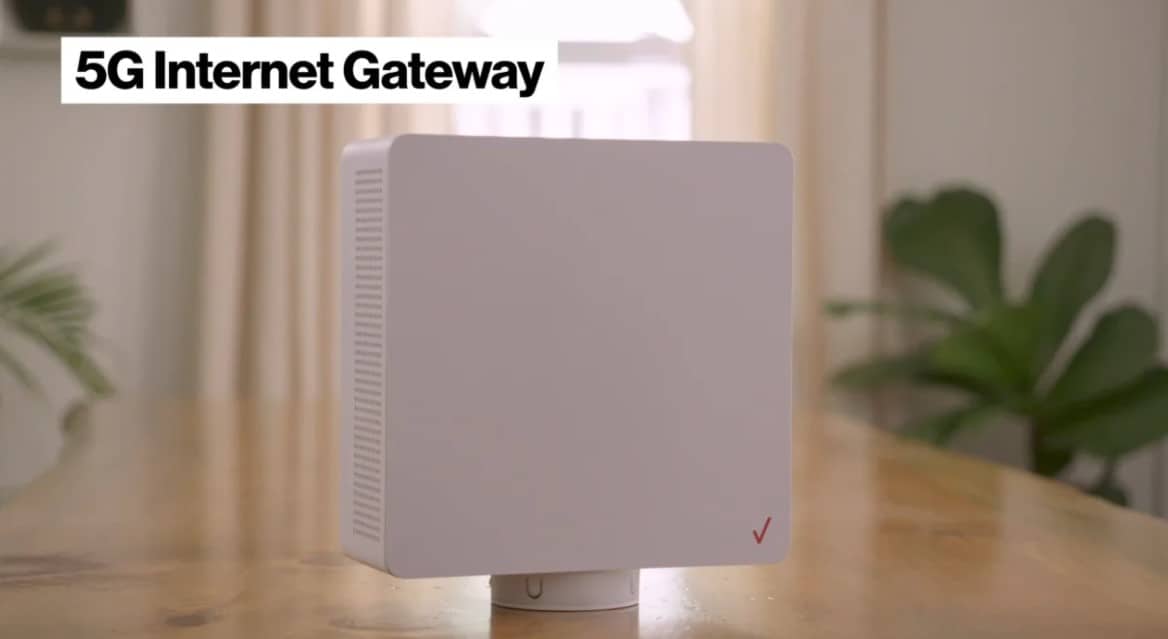Verizon 5G may be getting a lot bigger. Today Verizon exclusively revealed to PCMag that it’s launching the first 5G home router powered by Qualcomm’s long-awaited QTM527 antenna, which has the potential to greatly expand the range of the carrier’s fast, but short-distance millimeter-wave 5G.
“The new hardware, apart from having a very slick design, has a longer range from a radio standpoint so more households will be covered,” said Frank Boulben, Verizon SVP of consumer marketing and products.
Verizon first introduced its 5G home internet service in late 2018, but expansion has been slow going. Earlier this year, Verizon’s Ronan Dunne told Light Reading that the company was waiting for new in-home hardware based on higher-power antennas. It looks like now that’s here.
The new router, made by Wistron for Verizon, can be placed inside by a window, so there’s no external install needed. A smartphone app guides you where to put the unit. The device has Wi-Fi 6 and one Ethernet port. The Ethernet port is important because Verizon’s millimeter-wave system is sometimes faster than the maximum speed of Wi-Fi routers; in tests in my neighborhood, I’ve gotten up to 1.7Gbps. Boulben said home users will get between 300Mbps and a gigabit.
The FCC details for the router, also known as the Wistron LV55, show that it also has 4G LTE capabilities on bands 2/5/13/66, but Verizon will only sell it in 5G-capable locations.
The router can be self-installed using an augmented reality smartphone app.
The system still sounds a little finicky.
“If you live in a high rise [building, or] have special kinds of materials in your wall or window, and external antenna with a professional install will still be required,” Boulben said.
By window materials, he’s probably referring to low-E glass, a window coating that reduces the infrared and ultraviolet light inside your house. It also blocks millimeter-wave internet.
Verizon wouldn’t give us a map of its newly covered areas. You’ll have to punch your address into a tool on Verizon’s website on or after Oct. 1 to see if you’re covered. The areas will probably be based on Verizon’s mobile 5G coverage map, but be more extensive because of the increased power of the QTM527 antennas.
The carrier said that it’s also expanding its 5G home service to Minneapolis and St. Paul on Oct. 1, adding to its current list of Chicago, Detroit, Sacramento, Los Angeles, Houston, and Indianapolis. At least two more cities will follow by the end of the year, Boulben said.
Phenomenal Cosmic Power, Itty Bitty Network Coverage
Verizon has a ton of millimeter-wave spectrum available in the cities it serves, Boulben said. With an average of more than a gigahertz of airwaves, it doesn’t need to worry about network management. There’s more than enough for everyone to get blinding speeds at the moment.
What it doesn’t have is coverage. Our 26-city Fastest Mobile Networks tests used smartphones and found only single-digit percentages of coverage even in cities Verizon claimed to serve. The big question with the new router is how much the antennas will expand that coverage. That’s what Verizon so desperately needs right now.
Qualcomm quoted more than a half-mile of range to us back in 2019, which is considerably greater than what the first-generation home routers got. But that half-mile was based on a bigger box designed to be placed outside, rather than Verizon’s smaller indoor router. We’ll have to punch some addresses into Verizon’s address-qualifying tool to find out the real range.
Verizon’s service costs $50/month for Verizon Wireless customers and $70/month for everyone else. The router comes free with the service fee. It doesn’t require contracts, and it comes with a year of Disney+, a streaming TV box, an Echo Show 5, a Ring Stick Up Cam, an Echo Dot, and an Amazon Smart Plug. You can find out more at verizon.com/5g/home/.

